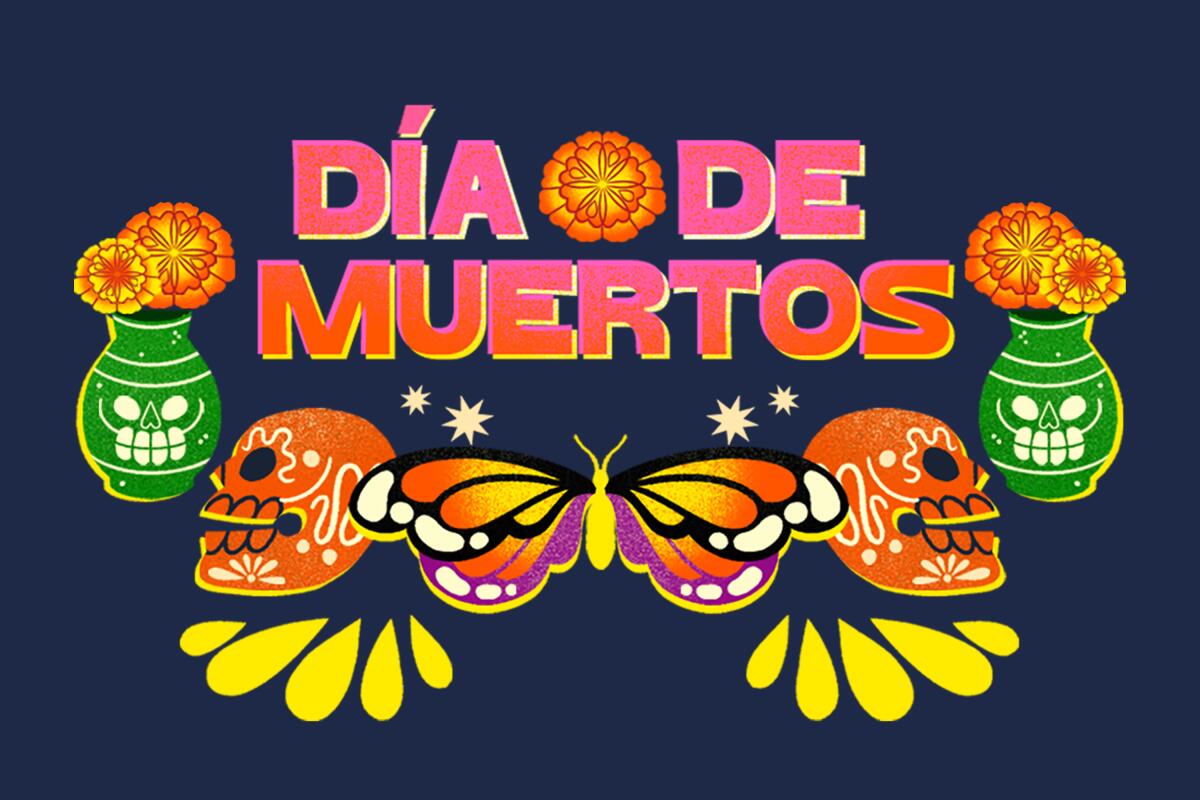Latinx Files: Our Día de Muertos digital ofrenda is back

- Share via
About a week ago, I got a package from a friend who lives on the other side of the country.
In it were assorted newspaper clippings of stories he thought I should read, a zine, a card with a nice handwritten message and a book. His father had written the latter, and since his passing a few years ago, my friend has gotten in the habit of buying copies of it and giving them away to a select few people.
I was so touched to have received the gift. I never met my friend’s father, but I felt privileged to help keep his memory alive.
The Latinx experience chronicled
Get the Latinx Files newsletter for stories that capture the multitudes within our communities.
You may occasionally receive promotional content from the Los Angeles Times.
The package couldn’t have arrived at a better moment. On Monday, the De Los team announced that we were taking submissions for The Times’ now annual Día de Muertos digital altar.
For those unfamiliar, in 2021, assistant data and graphics editor Vanessa Martínez, deputy design director Martina Ibañez-Baldor and I built a tool with which readers could make digital ofrendas to loved ones who had died by uploading a photo and a short memory of that person. We wanted to create a communal online space to substitute for the many Southern California Día de Muertos events canceled by the COVID-19 pandemic.
The Día de Muertos digital altar was so successful — we got close to 1,000 submissions in three languages — that we felt compelled to do it indefinitely. After all, for as long as death continues to take our loved ones away from us, there will always be a need to share the burden of grief and the comfort of their memories with others.
Consider subscribing to the Los Angeles Times
Your support helps us deliver the news that matters most. Become a subscriber.
On a personal note, it’s by far the most fulfilling project I’ve ever been involved with. Reading through the submissions of people choosing to honor their loved ones elicits the same feeling I got from receiving that book from my friend.
The digital altar will go live on Monday — I’ll be sure to link to it in this space next week. In the meantime, if you would like to submit an ofrenda, you can go here. Make sure to check out the De Los Día De Muertos coverage below:
Column: How a James Bond film made Día de Muertos absurd, in a fun way
Comic: The real history behind Día de Muertos
52 ways to celebrate Día de Muertos in L.A. and O.C.
These L.A. flower vendors prep for weeks so we can have cempasúchils on our ofrendas

Things we read this week that we think you should read
From De Los
How northern Mexico’s La Indepe uses cumbias colombianas to resist displacement: The barrios of La Indepe used to be the margins of the industrial city, but now they are encircled by urban development. Given the government’s initiatives, often presented as progress, these barrios are the last obstacle standing in the government’s way.
Fame is a frenemy in Bad Bunny’s “Nadie Sabe Lo Que Va a Pasar Mañana”: Ears-deep in his Hollywood era, Bad Bunny pulls back the curtain and lets us into his head in “Nadie Sabe Lo Que Va a Pasar Mañana.” Album review by Suzy Exposito.
Traitor, ghost, feminist icon— reclaiming the stories of La Llorona: Whether La Llorona is held up as a form of resistance against oppression, owning her power or reclaiming the monstrous bruja within, the narratives of the wailing woman have endured for centuries, reimagined into a radical icon.
Latinidad is inspiring these nail artists’ intricate designs: Latinidad can be expressed in multiple ways, and these Latinx entrepreneurs are using their nail art businesses to showcase their culture.
From the Times
As Biden visits, rage spreads amid dueling narratives from Israel, Hamas: With hundreds of Palestinian civilians reported dead in Gaza, dueling narratives from Israel and Hamas highlight danger that the war may spread.
Those campus rallies aren’t just pro-Palestinian. They’re anticolonial: To a certain kind of educated younger audience, the modern state of Israel looks a lot like yet another byproduct of European imperialism. Column by LZ Granderson.
Palestinian Americans stuck in Gaza as all-out Israeli invasion looms: Hundreds of Palestinian Americans are reportedly stranded in Gaza, frantically searching for ways to flee before Israel’s expected ground assault.
“I need to ask God why.” In Israel and Gaza, the scale of death overwhelms the living: In Israel, a quest to identify unrecognizable bodies. In Gaza, bodies are piled and some stored in ice cream trucks as power fails.
The Latinx experience chronicled
Get the Latinx Files newsletter for stories that capture the multitudes within our communities.
You may occasionally receive promotional content from the Los Angeles Times.




